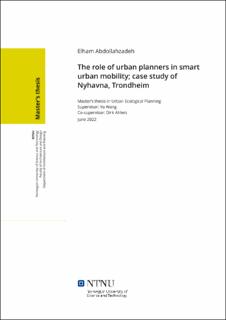| dc.description.abstract | The shift to the new era of smart cities has begun over a decade, and the new transformations are inevitable. Transportation planning is a crucial aspect of planning for the cities and has been influenced by this transition. With respect to planning for an urban transportation system, there is a gap between urban planners’ solutions to transportation problems and data-driven smart city solutions. This research aims to bridge the current smart city trend to urban planning. Urban planners should reach out for the available big data that is useful for the planning process and adopt the technology to collect the data they need. It is important to investigate how this data can be useful to optimise planning solutions. Technology can increase the speed of processing data with less mistake rate, which makes it more efficient and much cheaper. Urban planners can be creative to avoid falling behind the smart city transition.
On the other hand, smart cities are mainly pursuing ICT and IoT-based solutions, neglecting the fact that cities are like living creatures. Cities are relatively diverse and not easily predictable. The analysed data for each city and each neighbourhood could be interpreted differently. Therefore, urban planners should localise the criteria to assess each dataset. Inspecting human behaviour and culture to reach more compatible results. In addition, an important role of urban planners is to make sure that cities are inclusive, considering that not everyone can use technology equally.
This essay is analysing the Nyhavna district in Trondheim as a case study of smart urban mobility. Nyhavna has been a port area of Trondheim with industrial use for decades. This area is missing the potential to be used as an active, livable neighbourhood that connects the city centre to the fjord. Therefore, there has been extensive research undergoing for the new development of Nyhavna. Reflecting on Nyhavna as a pilot project considering the needs of smart cities before the developments can be relevant research since smart cities could extract the required data if the cities were planned to be smart in advance, and urban infrastructures could have been designed differently to meet the needs of smart urban planning. In this case, big data can help urban planners identify and solve urban problems faster and cheaper. The data can be provided by companies, research groups, and, most importantly, citizens. It is not clear if urban planners are ready to be smart. There are questions to be investigated further, such as: what are the problems that urban planners can solve using big data, what data are required, how to analyse the data, and how eventually it can help urban planners to predict the consequences of their decisions. | |
